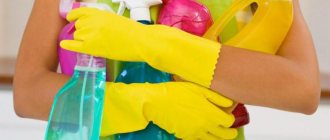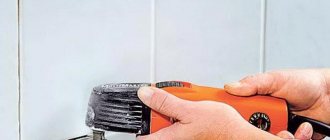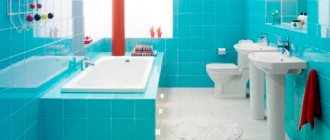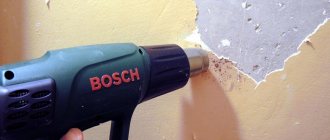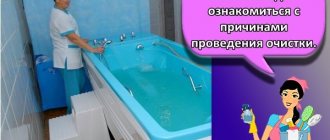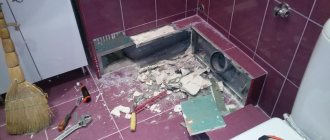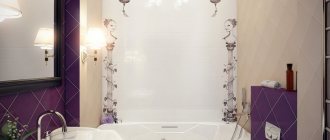Causes of plaque formation
The surface of the tiles in the bathroom is constantly exposed to water, soap solutions, and cosmetics. The liquid part evaporates, the drops dry out, leaving stains of salts, lime and other substances dissolved in water on the shiny tile.
It is not difficult to clean the tiles from dirt: water-soluble salts are wiped off with a sponge or rag. But in some cases, stains cannot be removed. The reasons for this may be:
- increased water hardness: after the moisture evaporates, insoluble lime compounds remain, which form white stains on the tiles;
- leaking taps: they stain the wall with rust, and after the drops dry, the yellowness is difficult to wash off;
- mold fungi: colonize tile joints, constantly appearing on the surface in the form of dark spots resembling dirt, and an unpleasant odor appears in the bathroom;
- consequences of the repair: drops of lime, paint, putty or grouting materials are easily washed off until completely set (within 24 hours), and after that they are more difficult to remove.
Washing tiles in the bathroom.
How often to wash?
You need to keep your bathroom clean every day, and not just on those days when you do a general cleaning of the house. To do this, it is enough to spend no more than 10-15 minutes in the bathroom.
After taking a bath or shower, rinse surfaces with clean water and wipe dry to get rid of stains. For regular maintenance of tiled walls, a glass and mirror cleaner is suitable.
Every week you need to pay attention to the seams between the tiles, because... they create a suitable environment for the active proliferation of bacteria. You need to carefully wipe the tile seam from plaque and dirt. You can use bleach and soda for this.
Every month you need to do a thorough cleaning of the bathroom, using as many products as possible. And not only those that can quickly wash bathroom tiles.
Even with daily wiping of surfaces in the bathroom, general cleaning requires a little more diligence. Therefore, you will need deodorizing products to remove odors, disinfectants, and those that can help get rid of old mold in hard-to-reach places that have not previously received enough attention.
General cleaning recommendations
You need to choose a cleaning agent to remove stains from tiles depending on the type of coating (tile, plastic, terracotta, etc.), as well as taking into account the type of dirt. Fresh stains of any origin can be easily wiped off with a soap and soda solution. Soda, as a soft abrasive, can even cope with rust or lime salts. But old stains will have to be removed with aggressive household chemicals.
Washing tiles with soap and soda solution.
To prevent damage to the wall covering during cleaning, you must follow the following rules for caring for it:
- when using acid-containing chemicals, protect tile joints;
- do not use hard metal sponges and brushes, do not scratch stains with a knife;
- It is better to choose thick gels;
- It will be possible to wash the tiles without streaks only by thoroughly rinsing the surface;
- After treatment, mirror glass tiles must be wiped with window cleaners until they shine.
Tile care
There are no housewives who don’t want everything in the bathroom to sparkle, look fresh and comfortable. Moreover, it is not at all necessary to resort to the help of professionals from the cleaning service to restore cleanliness. Achieving sparkling cleanliness in your bathroom and sprucing it up yourself is not so difficult using modern methods and cleaning products.
The main thing is not to wait for the tiles to start attracting attention because they are faded or ready to fall off!
Correcting minor imperfections in a timely manner and maintaining a clear wall cleaning schedule will prevent major problems and keep your bathroom shiny and safe.
How to prevent problems from occurring?
To prevent the destruction of the decorative coating on the walls in the plumbing room, just listen to the advice of professionals:
- Immediately after renovation. Within a few days after installation, a whitish salt coating will appear on the surface of the cladding. This occurs due to the evaporation of moisture. The plaque must be washed off with an acid solution.
- Unglazed tiles should be periodically coated with liquid wax, glossy tiles with vinegar.
- It is also possible to avoid the occurrence of mold fungi. To ensure good ventilation in the room, there must be a ventilation gap of at least 2.5 cm between the door and the threshold.
- After each hygienic procedure, the walls should be wiped dry with a soft cloth. Terry or bamboo towels, microfiber, and suede are suitable for this purpose.
- You can use glass cleaner to make the tiles shine.
- You should familiarize yourself with the purpose and instructions for using the chemical in advance. You cannot use compositions on walls, for example, intended for cleaning toilets.
- The more concentrated the product, the less it should be kept on the surface being treated. When dealing with old plaque, it is better to repeat the procedure several times.
- You should use chlorine-containing cleaning products in the bathroom at least once a week.
But the most important advice: if you learn to pay attention to cleaning the bathroom every day, then general cleaning, which is necessary once a month, will not take more than 30 minutes.
Home Remedies
Improvised products are used in emergency situations, when you need to wash away dirt, but it is not possible to buy a suitable product. Limescale removal is carried out using acidic solutions:
Vinegar and lemon juice remove limescale from tiles.
- Vinegar dissolves traces of water droplets and will help remove grout or lime stains. Table varieties should be diluted with water 1:1, and for essence use 1 tsp. for ¾ glass of water. Soak a cloth in the solution and wash the tiles, rinse and wipe.
- Lemon juice or acid solution works in the same way as vinegar. You can use pure lemon juice or an acid solution of 1 tsp. for 1 glass of water.
You can remove cloudy deposits from drops of soapy water on the lining near the sink and bathtub using baking soda: moisten the powder, apply it to a sponge and wipe the wet wall. Rinse off the remaining soda with plenty of water so that there are no streaks from the powder itself.
An old toothbrush is useful for cleaning tile seams, joints in corners and other hard-to-reach places. It is convenient to treat smooth walls with a sponge. For wiping dry, rags made from natural fabrics are suitable.
Professional products
When choosing in the store how to clean the tiles in the bathroom from plaque, it is recommended to pay attention to the following household chemical products:
- MULTI FRESH . Produced by the Belgian company Cid Lines. It has a chemically balanced composition that removes most contaminants without streaks.
- CILLIT BANG Universal (purple bottle). Manufacturer: RECKITT BENCKISER. Removes limescale, rust, soap stains and other stubborn stains from various surfaces.
- CILLIT . The white bottle indicates that the product is designed specifically for cleaning surfaces from plaque and rust.
- SANI CLEAN SUPER . Designed for removing lime deposits from acid-resistant surfaces. Before cleaning the tiles in the bathroom, you need to dilute it according to the instructions.
- Sanitol . Manufacturer: GREENFIELD. Removes salt deposits on tiled bathroom walls, instantly dissolves soap stains, and adds shine to the surface.
- Gel SANITA . Russian product produced by the Stupino Chemical Plant. The bottle has an additional mark “Anti-rust”, but the gel effectively removes limescale and gives the surface a shine.
- CHISTIN gel . Another domestic product. Positioned as a sanitary and hygienic product that is used for washing any plumbing equipment, tiles, earthenware.
- Kenolux S100 . The Belgian product contains lactic acid, which can remove any dirt from the surface of the walls. The product is considered safe for seams and putty.
- HELP . Gel-like product for tiles and plumbing. Suitable for full-scale cleaning of plumbing units - cleaning walls, toilets, sinks, taps. Effectively removes water stone and rust. Gives surfaces shine.
- Mr. Proper . The liquid product is considered universal and does an excellent job of removing any old stains on tiles. Does not leave streaks and fills the room with a pleasant aroma.
Household chemicals have a number of advantages. They do an excellent job of destroying bacteria, unpleasant odors, and mineral deposits, but their cost makes us remember that traditional methods also cope with washing tiles just as well.
Cleaning tiles using traditional methods
If the use of reliable but caustic chemicals is not possible, you can remove dirt and stains on the walls of the bathroom and bring the tiles to a shine using the folk method. You will need:
- 100 ml hot water;
- 100 g of sound soap shavings;
- 2 tbsp. l. hydrogen peroxide;
- 2 tbsp. l. table vinegar (6-9%);
- 75 g baking soda.
Using a special solution prepared at home, you can give the tiles their former shine and shine.
Dissolve the soap in water, adding it in small portions. Add baking soda powder and leave the mixture for 24 hours. Add the remaining ingredients, moisten the tile with water and apply the prepared mixture. Leave for 5-7 minutes, then rub the seams with a brush, rinse the surface of the wall or floor with a sponge. Finally, rinse thoroughly with water and wipe dry.
An ammonia aqueous solution, which is used to wash glass, will also work well with stains on tiles or other glossy tiles (porcelain, mirror, etc.). Ammonia is used after washing the walls in the bathroom to bring the tiles to a shine. Glass cleaners can be used for the same purpose.
How to clean tile grout?
When tiling a bathroom, the seams between the tiles are the most demanding areas to care for . They have a more porous surface compared to tiles, and it is in the seams that mold most often forms and dirt accumulates.
To handle the joints of tile slabs, it is convenient to use brushes with small bristles. For example, old teeth.
Chlorine-containing preparations
One of the products with chlorine, for example Domestos or Belizna, can help clean white seams . This treatment also serves as a means of preventing mold. But it cannot be used on colored grout.
Steam cleaner
If possible, the seams between the tiles, as well as the tile itself, can be treated with a steam cleaner. This method is hygienic and does not require the use of additional cleaning products.
Hydrogen peroxide
To bleach white grout, use the following mixture:
- hydrogen peroxide – ¼ tbsp.;
- water – ½ cup;
- liquid soap – 1 tbsp. l.
All ingredients are mixed. This product can be stored. But if a brush has already been dipped into it during cleaning, the solution is used for only one procedure, and the residue is poured out.
Whitening markers
A special whitening marker will help to refresh the grout while simultaneously treating the joints from mold. If the mold damage is serious and deep, then it must be completely removed and replaced with a new one containing components that protect against fungus and mold.
When starting to clean grout, you need to take into account that strong compounds can damage the grout.
The video will tell you how and with what to clean tile joints:
Specialized household chemicals
Many products only remove fresh dirt well. It is difficult to remove old limescale or rust with them.
Silit Bang dissolves fats and breaks down lime deposits.
At home, it is convenient to use strong but not too aggressive drugs:
- "Silit Bang". Breaks down fats, dissolves lime deposits, and can remove yellow rust stains. The composition is non-aggressive towards all materials used for cladding: it can be used to clean acrylic and various types of plastic, porcelain stoneware, tiles with various surfaces, glass.
- "Mister Muscle". Dissolves soap and lime stains, is easily washed off with water and leaves no marks on different types of wall coverings.
- "Comet". The products are available in the form of sprays and gels with cleaning properties. If you need to quickly wipe clean surfaces to maintain shine, use a spray, but it is more convenient to treat difficult stains with gels.
- Kiilto Clean for tiles. The product contains oxalic acid and is harmless to glossy glazed ceramic surfaces, but can damage gypsum grout.
- "Domestos". Thick gels and sprays have a bactericidal effect. The bathroom will not only be clean, but also safe for health. When mold appears, the tile joints are treated with thick gel.
Domestes rids tiles of mold.
Cleaning joints between tiles
The tile seams are the most vulnerable spot on a tiled wall. They quickly lose color because... Dirt most often accumulates in them and mold develops. They are also unstable to some cleaning agents. For example, under the influence of hard tools and acidic detergents, the grout mixture may collapse.
The following are considered safe for cleaning seams:
- Steam cleaner. A powerful jet of steam will not only clean any type of dirt, but also get rid of fungal infections. No additional chemicals are required.
- Toothbrush. It is convenient and safe to apply cleaning compounds.
- Gel and liquid bleaches and antiseptics.
If the seams cannot be cleaned or the area of clearance is large, then the easiest way is to replace the grout. To do this, you need to arm yourself with a thin, sharp tool (such as a scraper) to clean out the damaged grout, a new mixture (preferably epoxy) and a rubber spatula. During work, the seams must be soaked with an antiseptic.
Bleaching the seams
Seams that have darkened but remain intact and not affected by mold can be bleached. For work, use household chemicals or improvised products. The most common of them:
- Marker. It is simple to use, but the effect of such an update is short-lived.
- Ready-to-use composition with a whitening component - German Mellerud, Canadian Grout. Both products are designed for cleaning grout, have properties that restore the color of grout, and remove mold and stains.
- A mixture of hydrogen peroxide and baking soda. A paste of these ingredients is rubbed into the seams with a toothbrush and left for 1-2 hours. Then the seams are thoroughly wiped.
Features of washing different types of tiles
When trying to wipe dirt off tiles, it is advisable to take into account the nature of the surface. On smooth, glossy walls, plaque forms quickly, but it is easy to visually detect and remove immediately. Other types of ceramic tiles need to be cleaned properly to achieve a satisfactory result.
Glossy
Glossy surfaces are especially difficult to keep clean. But it is also easier to remove stains from them than from other types of tiles. Plaque is removed from the glaze using chemicals that contain ammonia or ethyl alcohol: these are most products for window glass. The preparations are equipped with a spray bottle, are easy to apply, and when wiped dry, the surface becomes shiny.
Window glass cleaners are most often used to clean glossy surfaces in the bathroom.
Matte tile
Ceramic tiles without glaze are covered with stains from soap solutions or water. You can eliminate them:
- acidified water (0.5 cup per 5 liters of water), if they are caused by lime deposits;
- a solution of soda ash (3 tablespoons per 5 liters of water);
- special polish.
Cleaning matte tiles in the bathroom.
Embossed
The textured surface of the tile makes it difficult to remove dirt with a simple rag or sponge: not only plaque or rust remains in the small recesses of the pattern, but also dirty water after washing. If they are not removed immediately, they will create a dark coating. For cleaning, it is better to use special products that are completely washed off. The most convenient way to clean an uneven surface with an ornament or simply a fine texture is with a brush. After washing, it is advisable to wipe the wall or floor with moisture-absorbing material.
It is better to wash embossed tiles with special products.
Floor
For bathroom flooring, tiles with fine relief or without glaze are often used. These types are the safest: they will not allow you to slip on a wet floor. They need to be cleaned taking into account the characteristics of the surface, according to the rules for matte or embossed tiles. For floor tiles, special polishes are used (Emsal, etc.), which do not allow dirt to seep into the micropores of the ceramic.
For flooring, you should choose special polishes.
Folk remedies for use
Instead of store-bought products, housewives use traditional methods for cleaning bathroom surfaces. As practice shows, they are quite competitive.
Chlorine
Chlorine in powder form or a diluted solution of Whiteness is suitable for treating surfaces in the bathroom. The dry ingredient is diluted in water, after which the liquid is sprayed onto the dirt. After 15 minutes, wipe the tiles with a sponge to remove dirt. Feature of the product: when working with it you need to wear a mask and gloves.
Lemon acid
A bag of powder is diluted in 200-300 ml of warm water. After the crystals have dissolved, spray the product onto the stains. Exposure time – 10-15 minutes. The cleaning is completed by wiping the tiles with a damp cloth.
Soda and vinegar
Make a slurry from soda by combining the powder with water. It is used to treat stains on the work surface and leave for a couple of minutes for the composition to penetrate deeply. Next, vinegar is sprayed over the soda and allowed to react for 3-5 minutes. All that remains is to wash off the components from the tile.
Ammonia
Effectively removes fungus and mold, limescale formation. First, prepare a working solution: 125 ml of alcohol is mixed with 4 liters of water. Apply the liquid to the surfaces and leave to react for 15 minutes. Cleaning is completed by washing the tiles with clean water using a sponge.
Melamine sponge
The sponge is made from melamine foam. The material is characterized by its ability to penetrate into the smallest cracks and pores. The product is effective against limescale, stains, yellow spots and other contaminants. The rules of application are simple: thoroughly wipe the surface with a dampened sponge.
How to clean the seams between tiles
Cleaning the joints between tiles.
The grout has many pores into which dirty cleaning solution, drops of soapy water and other substances become clogged. Fungus and mold often develop in the pores.
To treat the seams, use a small brush and any cleaning product with bactericidal properties. The composition of a folk or store remedy should not include acid. A soap-soda solution is suitable (for 1 liter of water, 50 g of soap shavings and 2 tablespoons of soda). Add 1 cap of “Whiteness” or 0.5 tsp to it. chloramine.
It is convenient to use a steam generator to clean seams. A jet of hot steam destroys dirt and microorganism spores.
Available means
For minor fresh stains, you can use proven folk recipes that are always available at home.
Laundry soap
Laundry soap removes yellowness and whitens tiles well. It is enough to rub a brush or sponge with a bar of soap and treat the surface. The product gives a thick foam and stays on the surface for a long time. Leave the applied soap for 30-40 minutes, rinse with water and wipe the tiles dry.
Note: Whitening laundry soap is well suited for white tiles: it makes the surface snow-white and shiny. But on colored tiles it should be used with caution: in rare cases it can reduce the intensity of the color or make it uneven.
Vinegar
Acetic acid is successfully used to clean limescale from cladding. Vinegar is applied from a spray bottle or sponge. As a rule, the surface must be rubbed. If the plaque is relatively fresh, vinegar will remove it.
In combination with salt, vinegar is effective against rusty deposits. A napkin or rag is well moistened with vinegar, dipped in fine salt and carefully wiped off the rusty stains. An aqueous solution of vinegar is suitable for everyday tile care: the ingredients are mixed in equal parts and poured into a container with a spray bottle. The product can be sprayed on wall tiles and tile joints daily.
Baking or soda ash
Baking soda can remove grease, fresh rust, mold, dirt and water stone. Before treatment, the surface of the tile is moistened with water. Pour soda onto a wet sponge and rub the stained areas. The product is left for 15 – 30 minutes. During this time, the plaque usually softens and is easily wiped off with the hard side of a dish sponge or brush.
Note: For cleaning glossy tiles, soda ash is preferable: it dissolves better and has virtually no abrasive particles. A good cleaning effect is achieved due to a more alkaline reaction compared to baking soda. The advantage of soda ash is that when washed off, this product does not leave streaks. Therefore, when washing dark, matte or colored tiles, it is better to choose soda ash.
Hydrogen peroxide
Pharmacy 3% peroxide whitens yellowed seams, colored stains or traces of hair dye. On porous tiles, stains will have to be treated several times. The peroxide is gradually absorbed into the pores and after 3–4 applications, the stains usually noticeably lighten or disappear.
Ammonia
Ammonia is often included in liquids for washing glass, mirrors and other glossy surfaces. By itself, it does not remove stains well, but it is added to prevent streaks after washing. An aqueous solution of ammonia (2 tablespoons per 1 liter of water) is suitable for finishing the tiles after basic cleaning.
Lemon acid
Lemon or citric acid softens limescale and gives a slight whitening effect. Sprinkle the powder onto a sponge and wipe the tiles. In this way, you can wash the tiles from fresh deposits in 2-3 minutes.
Note: Citric acid powder may scratch the glaze of glossy tiles, so it must first be dissolved in a little water or replaced with lemon juice. It is not recommended to apply the product to seams - citric acid partially dissolves the grout, and when the product is washed off, white stains form on the tiles.
Tea tree oil
Tea tree essential oil is known for its antibacterial and antifungal properties. It can be used pure or added to household and industrial cleaning products. Regular use of tea tree oil is a good prevention of mold.
Mold Removal
Mold appears as small black spots in the joints of tiles. The peculiarity of the fungus is its ability to live and grow deeply into the plaster, from where it is completely impossible to remove it without repairs. A steam cleaner will quickly fix the problem. If mold was already in the bathroom before the new tiles were installed, the effect will be temporary.
Chlorine bleach will help fight mold on tiles.
Chlorine bleaches are effective against fungus on surfaces, but cannot completely destroy it. To permanently fix the problem, you need to use a radical method - remove the old putty and fill the joints with new grout. A special tool is used to remove the gypsum mixture, and the remains are removed with a brush.
Anti-mold treatment is as follows:
- Inject a fungicidal antiseptic into the seams, trying to wet the entire space between the seams (use a syringe);
- dry the wall;
- fill the joints with new putty, pushing it into the depth of the seam;
- wipe the surface of the tiles.
After introducing the fungicidal antiseptic and drying the wall, it is necessary to reapply the putty.
Remove mold
The warm and humid atmosphere of a plumbing room often causes mold to form. Mold must be removed immediately before the spores spread throughout the room. In the bathroom, mold can damage not only the tile seams, but also untiled walls, curtains, pipes, and plastic surfaces.
Mold eats deeply, damages furniture, and gives off an unpleasant odor. In addition, a room contaminated with mold poses a danger to human health.
Chlorine-containing products, copper sulfate, and vinegar will help get rid of black mold stains. Aqueous solutions prepared with these substances should be applied to the surface using a rag or spray bottle and left to act until completely dry. After a few hours, the applied products can be washed off with water and the room dried.
The treatment will have to be carried out several times with a break of 1-2 days. If mold has infected the tile joints, the grout will have to be scraped out and new grout applied after treatment with an antibacterial compound. Each treatment should be carried out in a well-dried and ventilated area.
Methods for restoring grout
There are several effective ways to update and lighten seams:
Marker for cleaning tile joints.
- Hardware stores sell products for cleaning bathroom tile joints. Markers and pencils allow you to quickly work on a seam by running the end of the lead along it.
- Paint the seams with waterproof paint or varnish and cover with polish.
- Partially renew the grout. This process is often combined with mold removal.
- If the putty has crumbled, it can be renewed by applying a fresh layer of the same composition. Before repairs, treat the joints with a stiff brush to remove the crumbling layer.
How to clean tiles until they shine after completing renovations
Completing a bathroom renovation is no reason to relax. Once the new fixtures are installed and the tiles are laid, you need to clean up, collecting all the leftover building materials, thereby bringing your new bathroom to perfection. At the same time, for different contaminants there are different ways to remove them.
Adhesive solution and silicone sealant
It is better to remove adhesives and sealants immediately, without waiting for them to harden on the surface of the tile. To do this, you only need a damp cloth.
But if you were unable to remove these contaminants in a timely manner, then you can get rid of them with the help of ammonia. Ammonia will soften dried-on dirt. Dissolve 30 ml of ammonia in a liter of water, add a little table vinegar. Soak a rag in the solution, cover the stain with it, after a quarter of an hour the dirt can be wiped off with a brush. Then rinse the surface with water.
Primer and cement
It is also better to remove primer and cement immediately after contact with the tiles. If after the repair there are dried whitish spots on the tiles, then a special construction solvent will help you out. It is inexpensive and suitable for cleaning most surfaces.
If you don't have a solvent on hand, use a simple acetone-based nail polish remover. It is applied to the problem area and covered with a napkin soaked in liquid. When the stains soften, carefully scrape them off the surface and rinse with water.
Grout
Soft grout options can be easily washed off with a simple soft sponge dipped in warm water. Wait for the composition to dry and wash off the surface.
If epoxy-based grout was chosen for repairs, then during work try to stain the tiles as little as possible. And remove any contaminants that still remain using a special solvent for such compositions.
Useful tips and prevention
To ensure that the seams are less exposed to moisture or cleaning agents, it is recommended that they be treated with a moisture-proof compound immediately after the repair is completed. The grout will last longer. Polishes are also applied to tiles with a porous surface (unglazed).
The best prevention of stains on tiles is timely cleaning. It is easier to wipe the walls when the stains have not yet had time to dry to the surface. You need to wash the walls in the bathroom once a week, and clean the seams once every 2-3 weeks.
Ventilation or frequent airing of the bathroom helps eliminate excess moisture. Mold will not grow in such conditions. After washing or taking a shower, it is advisable to wipe off drops of water from the tiles: this way there will be less dampness, and you won’t have to scrub off the stains.
Cleaning methods
Each housewife sets her own cleaning schedule. The bathroom is one of the most frequently visited rooms in the apartment, and if you do not distribute cleaning procedures to daily, weekly and monthly, this will complicate the general cleaning of the bathroom, which will be carried out from time to time.
In addition, due to daily water procedures, humid air accumulates in the bathroom, which promotes the proliferation of bacteria, microbes and fungi on all surfaces.
spring-cleaning
If you wipe the walls and plumbing fixtures dry every day after using the sink and shower, then classic general cleaning in the bathroom can be done once a month. You will have to wash the tiles from floor to ceiling, and therefore you need to free up the work space as much as possible.
It is necessary to remove and soak the curtain in a soapy solution, put all the bottles with gels and shampoos, washcloths, brushes and other small items in a separate container, and put the rug in the wash.
Before cleaning the tiles in the bathroom, you should apply detergent compositions to particularly dirty areas and leave for 20-30 minutes to act. Only after this can you begin global cleaning of the bathroom walls, treating tiled areas and other bathroom surfaces with household chemicals.
Quick cleaning
You can quickly wash the tiles in the bathroom after taking a shower. Under the influence of steam, which is formed during the hygienic procedure, dirt and plaque on the tiles become wet, and they can easily be removed with any gentle detergent or even just a soft cloth or sponge. All surfaces should then be wiped dry.
If the surfaces do not become shiny after such quick cleaning, it means that plaque has formed on the ceramic tiles. To get rid of it, you will need special professional or home cleaning products for tiles.
The use of chlorine-containing compounds is allowed. With their help, limescale deposits caused by excessively hard water and rust are quickly removed. In addition, compositions with chlorine are suitable not only for cleaning tiles, but also for antibacterial treatment of surfaces in the bathroom.
Household chemicals
- Table vinegar. It is in every home, we usually use it in the kitchen. But it can also be used well in the bathroom to clean grout and tiles - both from plaque and pathogenic microbes. To clean grout lines, you can use undiluted vinegar, but for the surface of the entire tile, it is better to dilute it in a ratio of 1 to 10; if necessary, the concentration can be increased. It is convenient to clean the seams with an old toothbrush, and apply vinegar to the rest of the surface for 10–15 minutes, then wipe with a rag and rinse with water.
- Lemon acid. A product similar in quality to vinegar, only weaker. But it has such an important advantage as a pleasant citrus smell after finishing cleaning.
- Bleaching, "Whiteness". It has been known since ancient times for its disinfecting properties and can wash away dirt and plaque, even remove mold stains. It is worth knowing that seams are bleached if they are colored or the shade of white becomes lighter. Therefore, before use, try cleaning a piece of seam with undiluted white to check. To clean the lining in the bathroom, you need to apply bleach and leave for 10 minutes, then rinse.
- Ammonia. It is used only in diluted form, as it has too strong a smell. Dilute 1-2 tablespoons in 2-3 liters of water. Helps not only clean the tiles, but also restore the gloss to its former shine! To do this, it is better to use a more concentrated solution of ammonia.
You can use the most common home remedies for cleaning.
- Soda. It’s also a proven cleaning product, sometimes it does a better job than many specialized products. It can be used to clean both plaque and mildly rooted fungus. To use, it is best to dilute it with water until it becomes sour cream. To give soda antiseptic properties, you can use it with the addition of hydrogen peroxide - then the microbes, along with fungus and mold, will be destroyed. You just have to know that you shouldn’t rub soda with special zeal, especially into glossy tiles, since soda contains small abrasives. After using soda, you must thoroughly wash and dry the treated surface.
- Borax. Used to remove fungus and mold. Does not cause allergies. Dilute with water 1 to 10 and clean with a brush. No need to wash after use.
- Copper sulfate. The fungus can be cleaned with vitriol, but it is toxic and should be used in well-ventilated areas. Dilute 1 to 10 and apply to the affected areas with a brush for several hours. After which it is thoroughly washed and dried.
How to clean tiles after renovation
Repairs heavily pollute any room, and this requires timely cleaning. When laying tiles, various problems may arise: paint stains, cement and soil stains, and more.
Before using cleaning products, do the following:
- Vacuum the walls and floor to remove dust and small particles;
- Using a spatula, remove excess solid particles;
- Rinse the surface with water.
During repair work, try to prevent glue or working solution from getting on the cladding, and if this does happen, immediately wipe off the dirt with a wet rag.
After this, you can use folk or chemical remedies. It is recommended to use active products, since stains formed during repairs cannot be easily removed.

